Effective Organizational Communication: Report and Analysis
VerifiedAdded on 2021/02/20
|9
|1920
|23
Report
AI Summary
This report provides an in-depth analysis of organizational communication, emphasizing its importance for business success. It explores different forms of communication, including formal, informal, and interpersonal, and examines the principles underlying effective communication. The report delves into the purposes of organizational communication, such as motivating employees, fostering social environments, and maintaining control. It further discusses key principles for effective communication, including goal setting, active listening, and the use of appropriate communication mediums. The report also evaluates communication practices, focusing on active listening, cultural sensitivity, and the management of criticism. The conclusion highlights the significance of these principles and practices for improving communication within organizations, supported by references to academic sources.
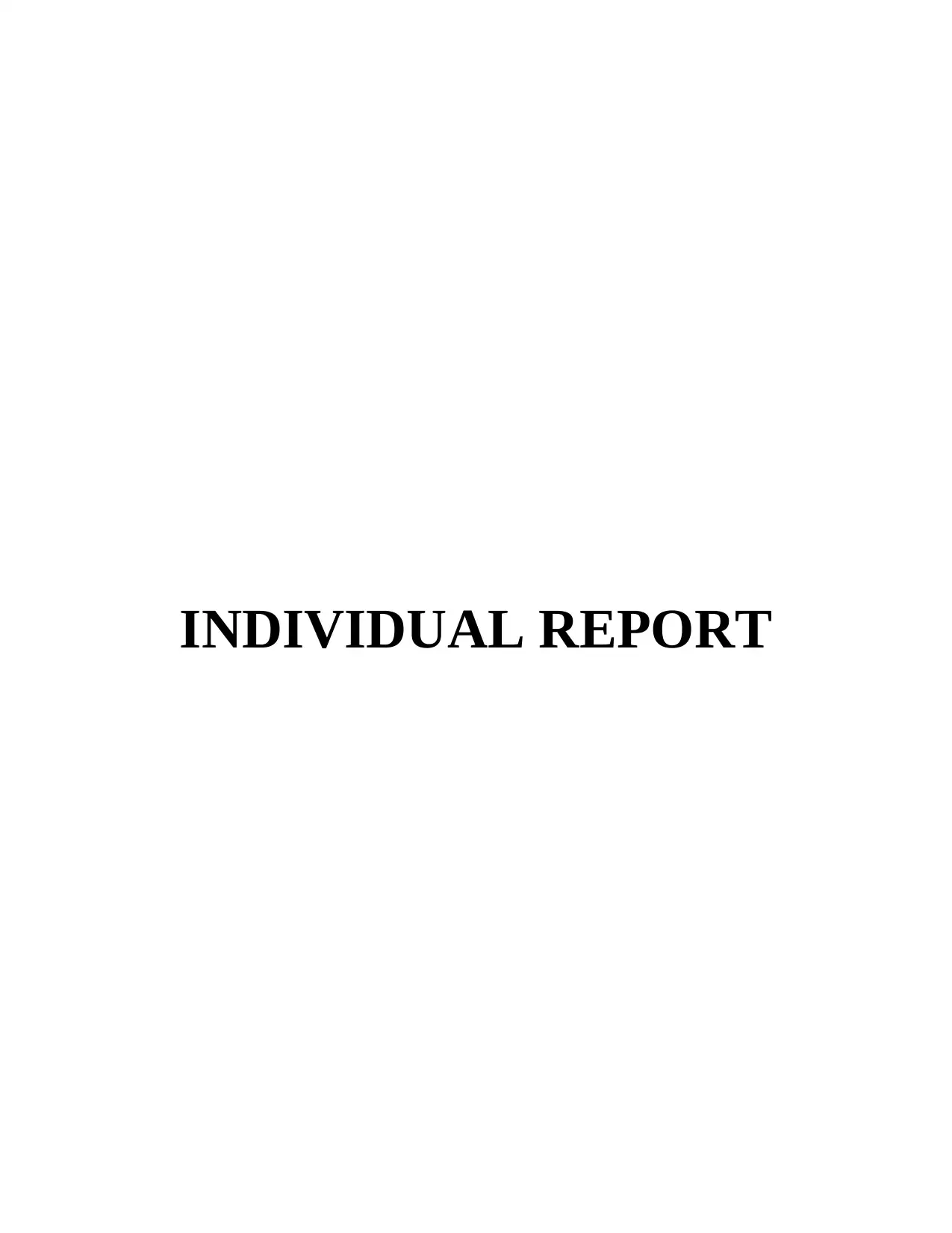
INDIVIDUAL REPORT
Paraphrase This Document
Need a fresh take? Get an instant paraphrase of this document with our AI Paraphraser
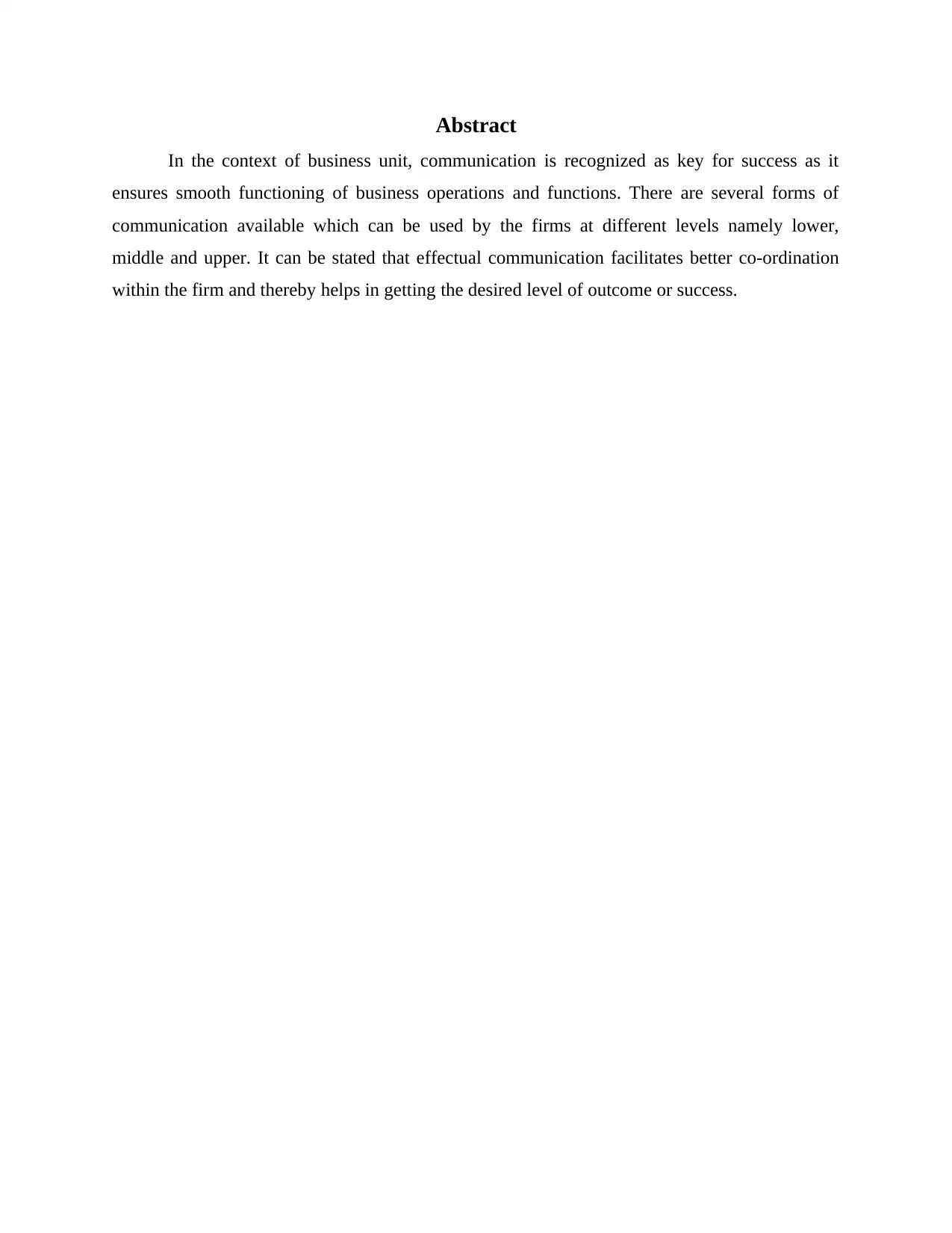
Abstract
In the context of business unit, communication is recognized as key for success as it
ensures smooth functioning of business operations and functions. There are several forms of
communication available which can be used by the firms at different levels namely lower,
middle and upper. It can be stated that effectual communication facilitates better co-ordination
within the firm and thereby helps in getting the desired level of outcome or success.
In the context of business unit, communication is recognized as key for success as it
ensures smooth functioning of business operations and functions. There are several forms of
communication available which can be used by the firms at different levels namely lower,
middle and upper. It can be stated that effectual communication facilitates better co-ordination
within the firm and thereby helps in getting the desired level of outcome or success.
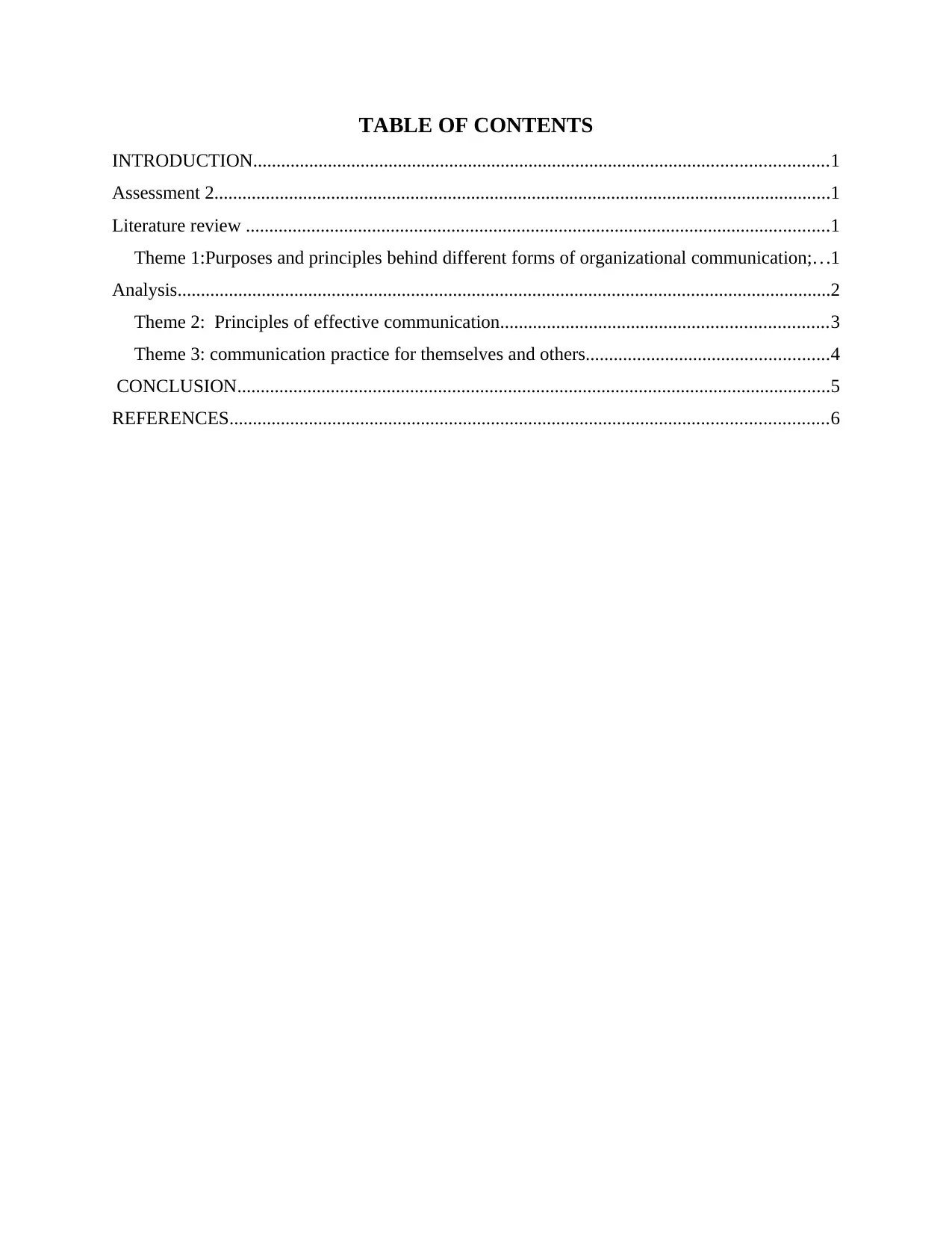
TABLE OF CONTENTS
INTRODUCTION...........................................................................................................................1
Assessment 2....................................................................................................................................1
Literature review .............................................................................................................................1
Theme 1:Purposes and principles behind different forms of organizational communication;. . .1
Analysis............................................................................................................................................2
Theme 2: Principles of effective communication......................................................................3
Theme 3: communication practice for themselves and others....................................................4
CONCLUSION...............................................................................................................................5
REFERENCES................................................................................................................................6
INTRODUCTION...........................................................................................................................1
Assessment 2....................................................................................................................................1
Literature review .............................................................................................................................1
Theme 1:Purposes and principles behind different forms of organizational communication;. . .1
Analysis............................................................................................................................................2
Theme 2: Principles of effective communication......................................................................3
Theme 3: communication practice for themselves and others....................................................4
CONCLUSION...............................................................................................................................5
REFERENCES................................................................................................................................6
⊘ This is a preview!⊘
Do you want full access?
Subscribe today to unlock all pages.

Trusted by 1+ million students worldwide
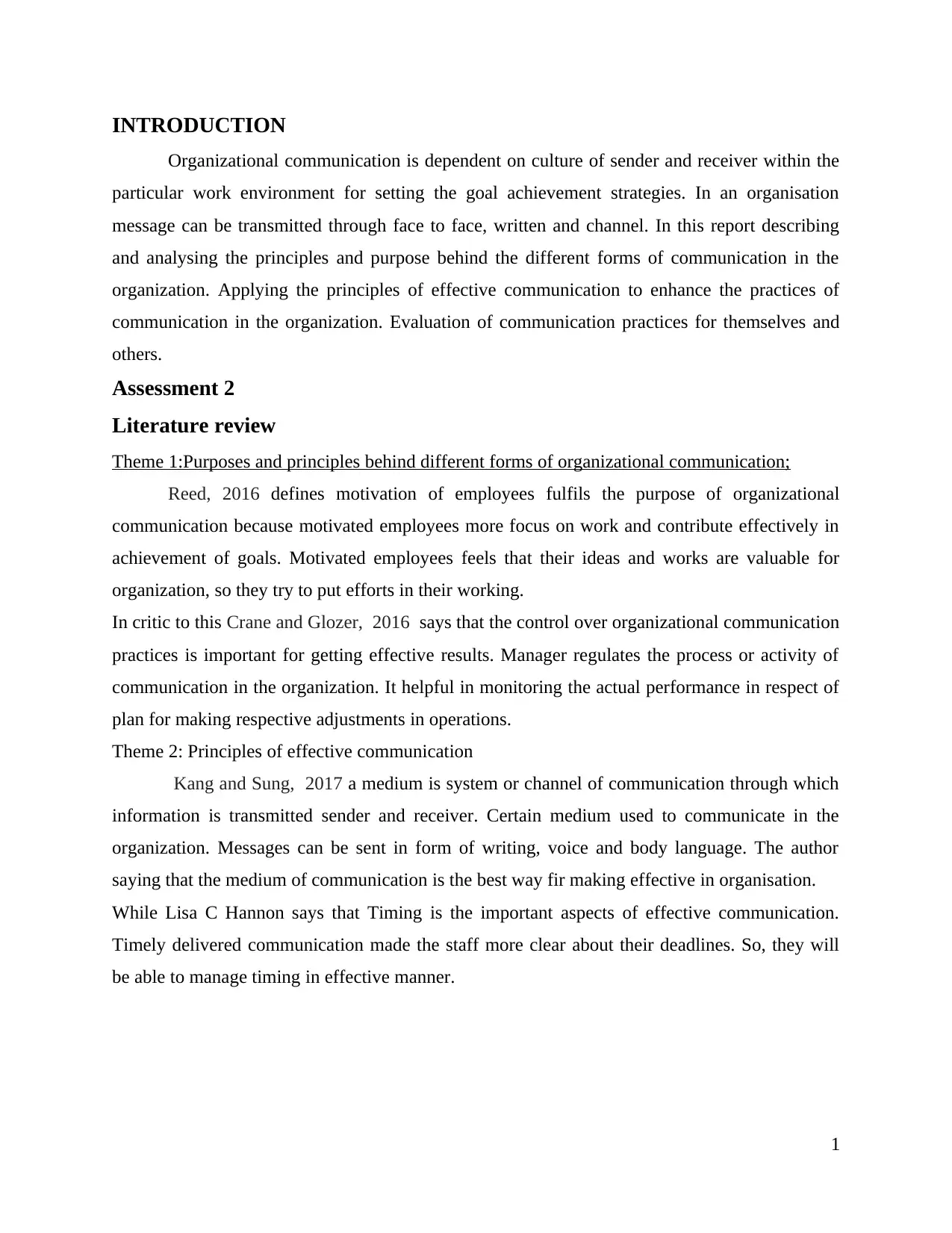
INTRODUCTION
Organizational communication is dependent on culture of sender and receiver within the
particular work environment for setting the goal achievement strategies. In an organisation
message can be transmitted through face to face, written and channel. In this report describing
and analysing the principles and purpose behind the different forms of communication in the
organization. Applying the principles of effective communication to enhance the practices of
communication in the organization. Evaluation of communication practices for themselves and
others.
Assessment 2
Literature review
Theme 1:Purposes and principles behind different forms of organizational communication;
Reed, 2016 defines motivation of employees fulfils the purpose of organizational
communication because motivated employees more focus on work and contribute effectively in
achievement of goals. Motivated employees feels that their ideas and works are valuable for
organization, so they try to put efforts in their working.
In critic to this Crane and Glozer, 2016 says that the control over organizational communication
practices is important for getting effective results. Manager regulates the process or activity of
communication in the organization. It helpful in monitoring the actual performance in respect of
plan for making respective adjustments in operations.
Theme 2: Principles of effective communication
Kang and Sung, 2017 a medium is system or channel of communication through which
information is transmitted sender and receiver. Certain medium used to communicate in the
organization. Messages can be sent in form of writing, voice and body language. The author
saying that the medium of communication is the best way fir making effective in organisation.
While Lisa C Hannon says that Timing is the important aspects of effective communication.
Timely delivered communication made the staff more clear about their deadlines. So, they will
be able to manage timing in effective manner.
1
Organizational communication is dependent on culture of sender and receiver within the
particular work environment for setting the goal achievement strategies. In an organisation
message can be transmitted through face to face, written and channel. In this report describing
and analysing the principles and purpose behind the different forms of communication in the
organization. Applying the principles of effective communication to enhance the practices of
communication in the organization. Evaluation of communication practices for themselves and
others.
Assessment 2
Literature review
Theme 1:Purposes and principles behind different forms of organizational communication;
Reed, 2016 defines motivation of employees fulfils the purpose of organizational
communication because motivated employees more focus on work and contribute effectively in
achievement of goals. Motivated employees feels that their ideas and works are valuable for
organization, so they try to put efforts in their working.
In critic to this Crane and Glozer, 2016 says that the control over organizational communication
practices is important for getting effective results. Manager regulates the process or activity of
communication in the organization. It helpful in monitoring the actual performance in respect of
plan for making respective adjustments in operations.
Theme 2: Principles of effective communication
Kang and Sung, 2017 a medium is system or channel of communication through which
information is transmitted sender and receiver. Certain medium used to communicate in the
organization. Messages can be sent in form of writing, voice and body language. The author
saying that the medium of communication is the best way fir making effective in organisation.
While Lisa C Hannon says that Timing is the important aspects of effective communication.
Timely delivered communication made the staff more clear about their deadlines. So, they will
be able to manage timing in effective manner.
1
Paraphrase This Document
Need a fresh take? Get an instant paraphrase of this document with our AI Paraphraser
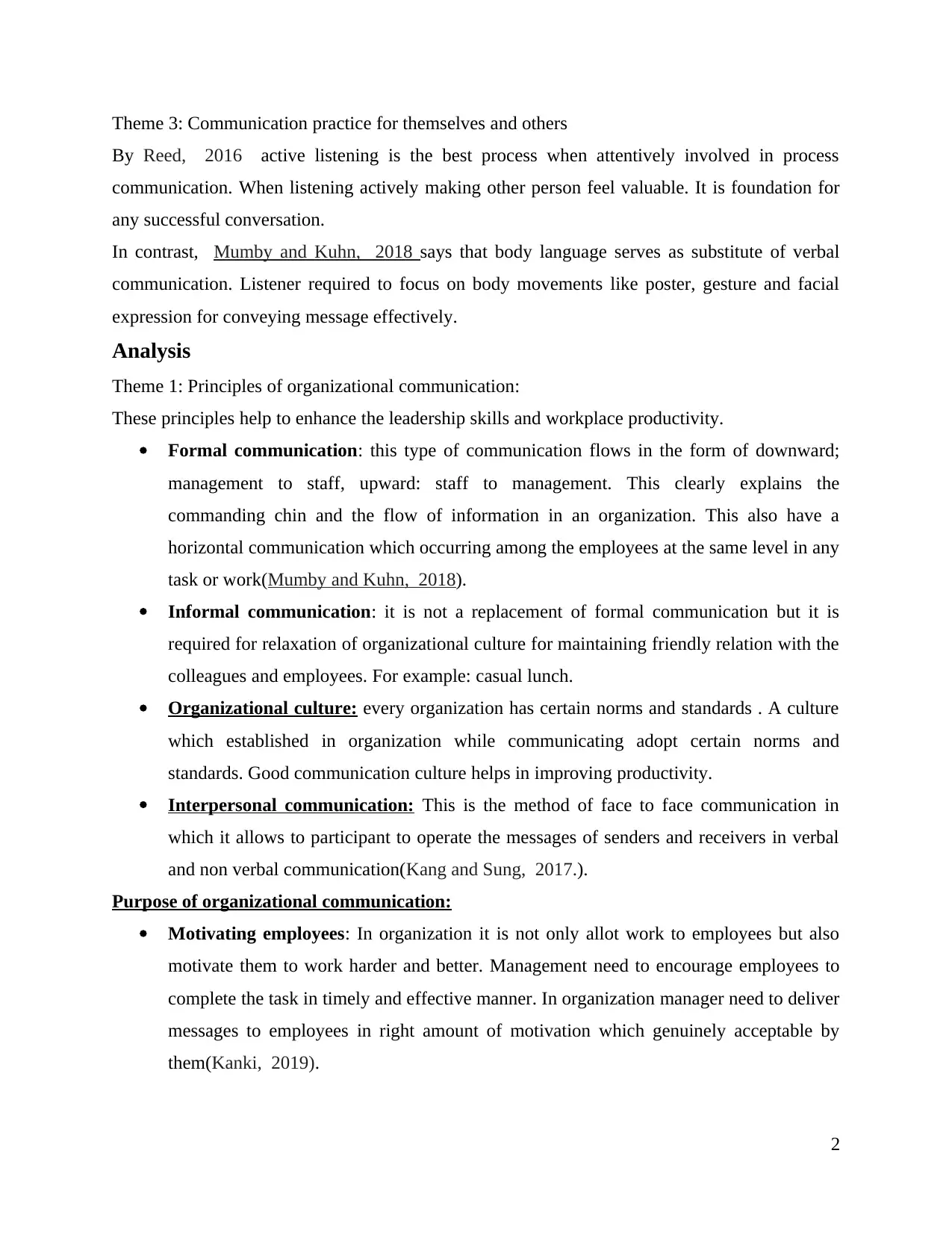
Theme 3: Communication practice for themselves and others
By Reed, 2016 active listening is the best process when attentively involved in process
communication. When listening actively making other person feel valuable. It is foundation for
any successful conversation.
In contrast, Mumby and Kuhn, 2018 says that body language serves as substitute of verbal
communication. Listener required to focus on body movements like poster, gesture and facial
expression for conveying message effectively.
Analysis
Theme 1: Principles of organizational communication:
These principles help to enhance the leadership skills and workplace productivity.
Formal communication: this type of communication flows in the form of downward;
management to staff, upward: staff to management. This clearly explains the
commanding chin and the flow of information in an organization. This also have a
horizontal communication which occurring among the employees at the same level in any
task or work(Mumby and Kuhn, 2018).
Informal communication: it is not a replacement of formal communication but it is
required for relaxation of organizational culture for maintaining friendly relation with the
colleagues and employees. For example: casual lunch.
Organizational culture: every organization has certain norms and standards . A culture
which established in organization while communicating adopt certain norms and
standards. Good communication culture helps in improving productivity.
Interpersonal communication: This is the method of face to face communication in
which it allows to participant to operate the messages of senders and receivers in verbal
and non verbal communication(Kang and Sung, 2017.).
Purpose of organizational communication:
Motivating employees: In organization it is not only allot work to employees but also
motivate them to work harder and better. Management need to encourage employees to
complete the task in timely and effective manner. In organization manager need to deliver
messages to employees in right amount of motivation which genuinely acceptable by
them(Kanki, 2019).
2
By Reed, 2016 active listening is the best process when attentively involved in process
communication. When listening actively making other person feel valuable. It is foundation for
any successful conversation.
In contrast, Mumby and Kuhn, 2018 says that body language serves as substitute of verbal
communication. Listener required to focus on body movements like poster, gesture and facial
expression for conveying message effectively.
Analysis
Theme 1: Principles of organizational communication:
These principles help to enhance the leadership skills and workplace productivity.
Formal communication: this type of communication flows in the form of downward;
management to staff, upward: staff to management. This clearly explains the
commanding chin and the flow of information in an organization. This also have a
horizontal communication which occurring among the employees at the same level in any
task or work(Mumby and Kuhn, 2018).
Informal communication: it is not a replacement of formal communication but it is
required for relaxation of organizational culture for maintaining friendly relation with the
colleagues and employees. For example: casual lunch.
Organizational culture: every organization has certain norms and standards . A culture
which established in organization while communicating adopt certain norms and
standards. Good communication culture helps in improving productivity.
Interpersonal communication: This is the method of face to face communication in
which it allows to participant to operate the messages of senders and receivers in verbal
and non verbal communication(Kang and Sung, 2017.).
Purpose of organizational communication:
Motivating employees: In organization it is not only allot work to employees but also
motivate them to work harder and better. Management need to encourage employees to
complete the task in timely and effective manner. In organization manager need to deliver
messages to employees in right amount of motivation which genuinely acceptable by
them(Kanki, 2019).
2
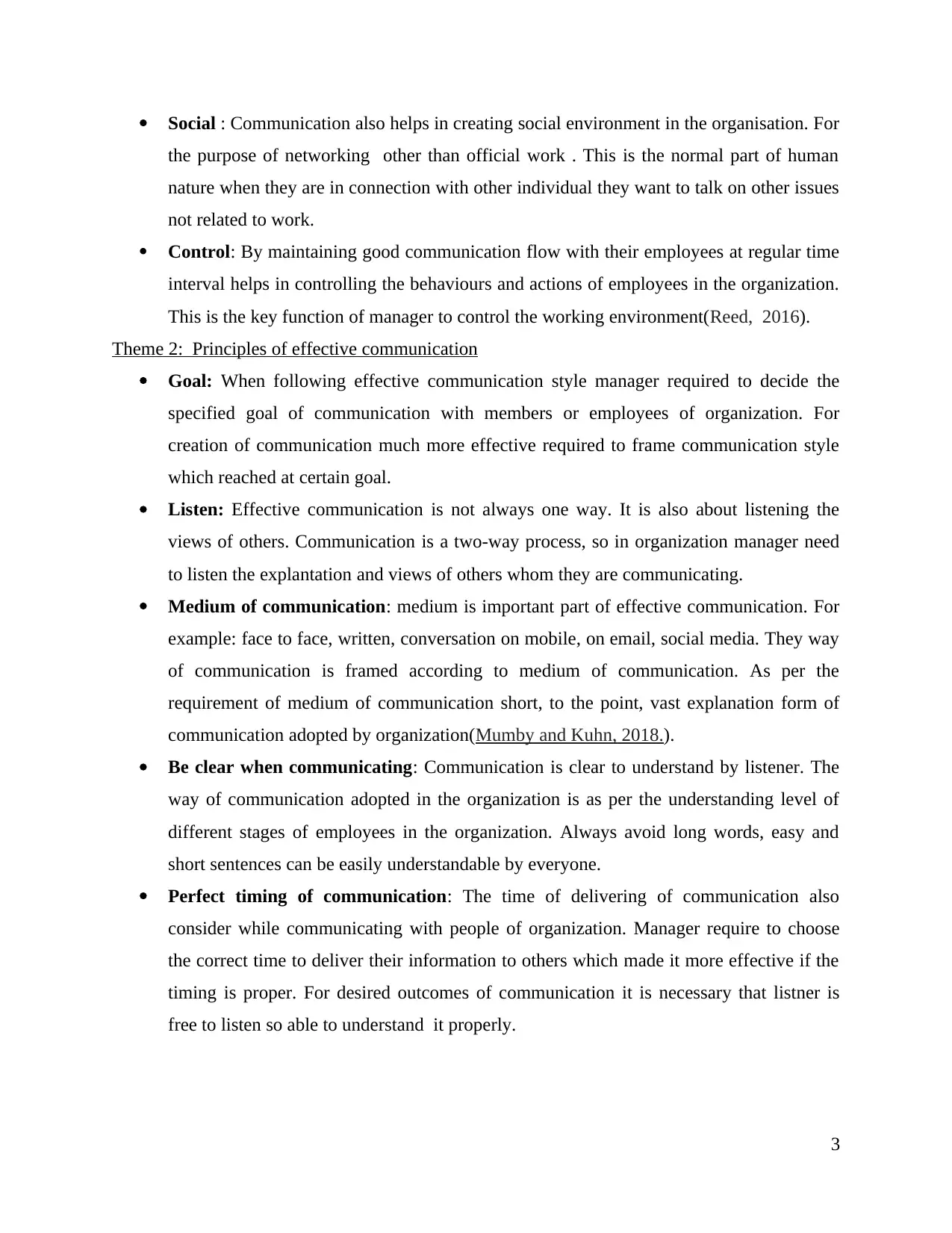
Social : Communication also helps in creating social environment in the organisation. For
the purpose of networking other than official work . This is the normal part of human
nature when they are in connection with other individual they want to talk on other issues
not related to work.
Control: By maintaining good communication flow with their employees at regular time
interval helps in controlling the behaviours and actions of employees in the organization.
This is the key function of manager to control the working environment(Reed, 2016).
Theme 2: Principles of effective communication
Goal: When following effective communication style manager required to decide the
specified goal of communication with members or employees of organization. For
creation of communication much more effective required to frame communication style
which reached at certain goal.
Listen: Effective communication is not always one way. It is also about listening the
views of others. Communication is a two-way process, so in organization manager need
to listen the explantation and views of others whom they are communicating.
Medium of communication: medium is important part of effective communication. For
example: face to face, written, conversation on mobile, on email, social media. They way
of communication is framed according to medium of communication. As per the
requirement of medium of communication short, to the point, vast explanation form of
communication adopted by organization(Mumby and Kuhn, 2018.).
Be clear when communicating: Communication is clear to understand by listener. The
way of communication adopted in the organization is as per the understanding level of
different stages of employees in the organization. Always avoid long words, easy and
short sentences can be easily understandable by everyone.
Perfect timing of communication: The time of delivering of communication also
consider while communicating with people of organization. Manager require to choose
the correct time to deliver their information to others which made it more effective if the
timing is proper. For desired outcomes of communication it is necessary that listner is
free to listen so able to understand it properly.
3
the purpose of networking other than official work . This is the normal part of human
nature when they are in connection with other individual they want to talk on other issues
not related to work.
Control: By maintaining good communication flow with their employees at regular time
interval helps in controlling the behaviours and actions of employees in the organization.
This is the key function of manager to control the working environment(Reed, 2016).
Theme 2: Principles of effective communication
Goal: When following effective communication style manager required to decide the
specified goal of communication with members or employees of organization. For
creation of communication much more effective required to frame communication style
which reached at certain goal.
Listen: Effective communication is not always one way. It is also about listening the
views of others. Communication is a two-way process, so in organization manager need
to listen the explantation and views of others whom they are communicating.
Medium of communication: medium is important part of effective communication. For
example: face to face, written, conversation on mobile, on email, social media. They way
of communication is framed according to medium of communication. As per the
requirement of medium of communication short, to the point, vast explanation form of
communication adopted by organization(Mumby and Kuhn, 2018.).
Be clear when communicating: Communication is clear to understand by listener. The
way of communication adopted in the organization is as per the understanding level of
different stages of employees in the organization. Always avoid long words, easy and
short sentences can be easily understandable by everyone.
Perfect timing of communication: The time of delivering of communication also
consider while communicating with people of organization. Manager require to choose
the correct time to deliver their information to others which made it more effective if the
timing is proper. For desired outcomes of communication it is necessary that listner is
free to listen so able to understand it properly.
3
⊘ This is a preview!⊘
Do you want full access?
Subscribe today to unlock all pages.

Trusted by 1+ million students worldwide
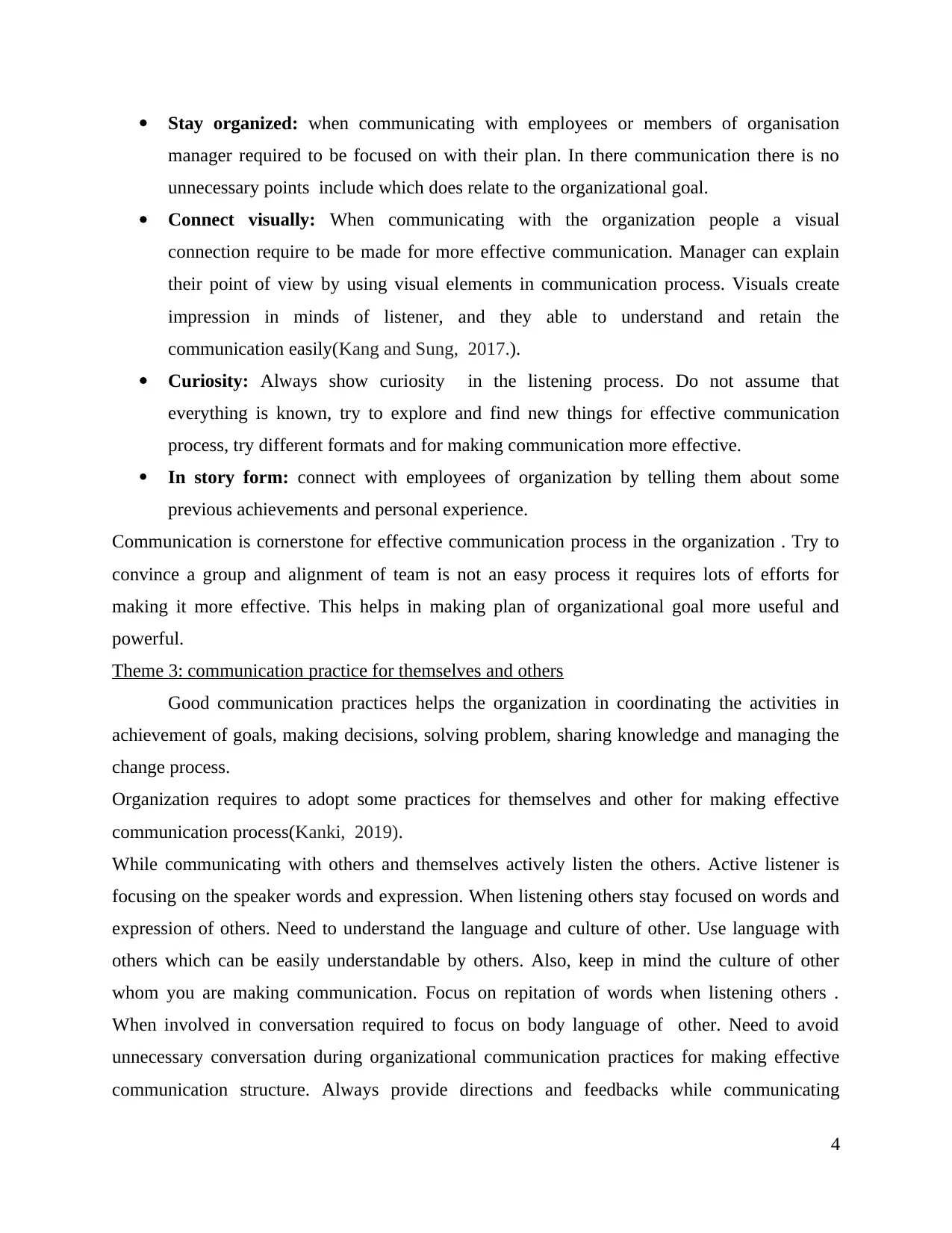
Stay organized: when communicating with employees or members of organisation
manager required to be focused on with their plan. In there communication there is no
unnecessary points include which does relate to the organizational goal.
Connect visually: When communicating with the organization people a visual
connection require to be made for more effective communication. Manager can explain
their point of view by using visual elements in communication process. Visuals create
impression in minds of listener, and they able to understand and retain the
communication easily(Kang and Sung, 2017.).
Curiosity: Always show curiosity in the listening process. Do not assume that
everything is known, try to explore and find new things for effective communication
process, try different formats and for making communication more effective.
In story form: connect with employees of organization by telling them about some
previous achievements and personal experience.
Communication is cornerstone for effective communication process in the organization . Try to
convince a group and alignment of team is not an easy process it requires lots of efforts for
making it more effective. This helps in making plan of organizational goal more useful and
powerful.
Theme 3: communication practice for themselves and others
Good communication practices helps the organization in coordinating the activities in
achievement of goals, making decisions, solving problem, sharing knowledge and managing the
change process.
Organization requires to adopt some practices for themselves and other for making effective
communication process(Kanki, 2019).
While communicating with others and themselves actively listen the others. Active listener is
focusing on the speaker words and expression. When listening others stay focused on words and
expression of others. Need to understand the language and culture of other. Use language with
others which can be easily understandable by others. Also, keep in mind the culture of other
whom you are making communication. Focus on repitation of words when listening others .
When involved in conversation required to focus on body language of other. Need to avoid
unnecessary conversation during organizational communication practices for making effective
communication structure. Always provide directions and feedbacks while communicating
4
manager required to be focused on with their plan. In there communication there is no
unnecessary points include which does relate to the organizational goal.
Connect visually: When communicating with the organization people a visual
connection require to be made for more effective communication. Manager can explain
their point of view by using visual elements in communication process. Visuals create
impression in minds of listener, and they able to understand and retain the
communication easily(Kang and Sung, 2017.).
Curiosity: Always show curiosity in the listening process. Do not assume that
everything is known, try to explore and find new things for effective communication
process, try different formats and for making communication more effective.
In story form: connect with employees of organization by telling them about some
previous achievements and personal experience.
Communication is cornerstone for effective communication process in the organization . Try to
convince a group and alignment of team is not an easy process it requires lots of efforts for
making it more effective. This helps in making plan of organizational goal more useful and
powerful.
Theme 3: communication practice for themselves and others
Good communication practices helps the organization in coordinating the activities in
achievement of goals, making decisions, solving problem, sharing knowledge and managing the
change process.
Organization requires to adopt some practices for themselves and other for making effective
communication process(Kanki, 2019).
While communicating with others and themselves actively listen the others. Active listener is
focusing on the speaker words and expression. When listening others stay focused on words and
expression of others. Need to understand the language and culture of other. Use language with
others which can be easily understandable by others. Also, keep in mind the culture of other
whom you are making communication. Focus on repitation of words when listening others .
When involved in conversation required to focus on body language of other. Need to avoid
unnecessary conversation during organizational communication practices for making effective
communication structure. Always provide directions and feedbacks while communicating
4
Paraphrase This Document
Need a fresh take? Get an instant paraphrase of this document with our AI Paraphraser
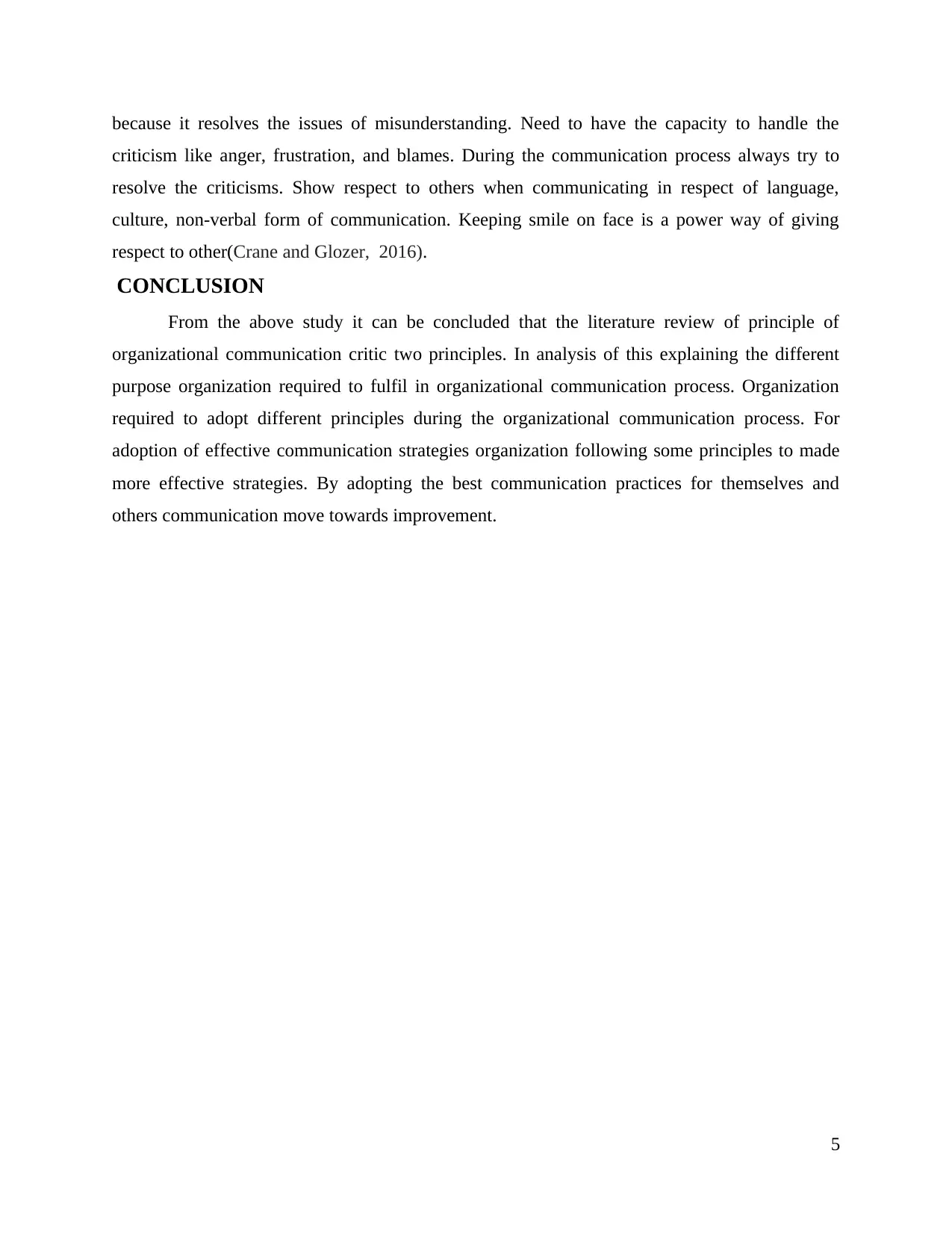
because it resolves the issues of misunderstanding. Need to have the capacity to handle the
criticism like anger, frustration, and blames. During the communication process always try to
resolve the criticisms. Show respect to others when communicating in respect of language,
culture, non-verbal form of communication. Keeping smile on face is a power way of giving
respect to other(Crane and Glozer, 2016).
CONCLUSION
From the above study it can be concluded that the literature review of principle of
organizational communication critic two principles. In analysis of this explaining the different
purpose organization required to fulfil in organizational communication process. Organization
required to adopt different principles during the organizational communication process. For
adoption of effective communication strategies organization following some principles to made
more effective strategies. By adopting the best communication practices for themselves and
others communication move towards improvement.
5
criticism like anger, frustration, and blames. During the communication process always try to
resolve the criticisms. Show respect to others when communicating in respect of language,
culture, non-verbal form of communication. Keeping smile on face is a power way of giving
respect to other(Crane and Glozer, 2016).
CONCLUSION
From the above study it can be concluded that the literature review of principle of
organizational communication critic two principles. In analysis of this explaining the different
purpose organization required to fulfil in organizational communication process. Organization
required to adopt different principles during the organizational communication process. For
adoption of effective communication strategies organization following some principles to made
more effective strategies. By adopting the best communication practices for themselves and
others communication move towards improvement.
5
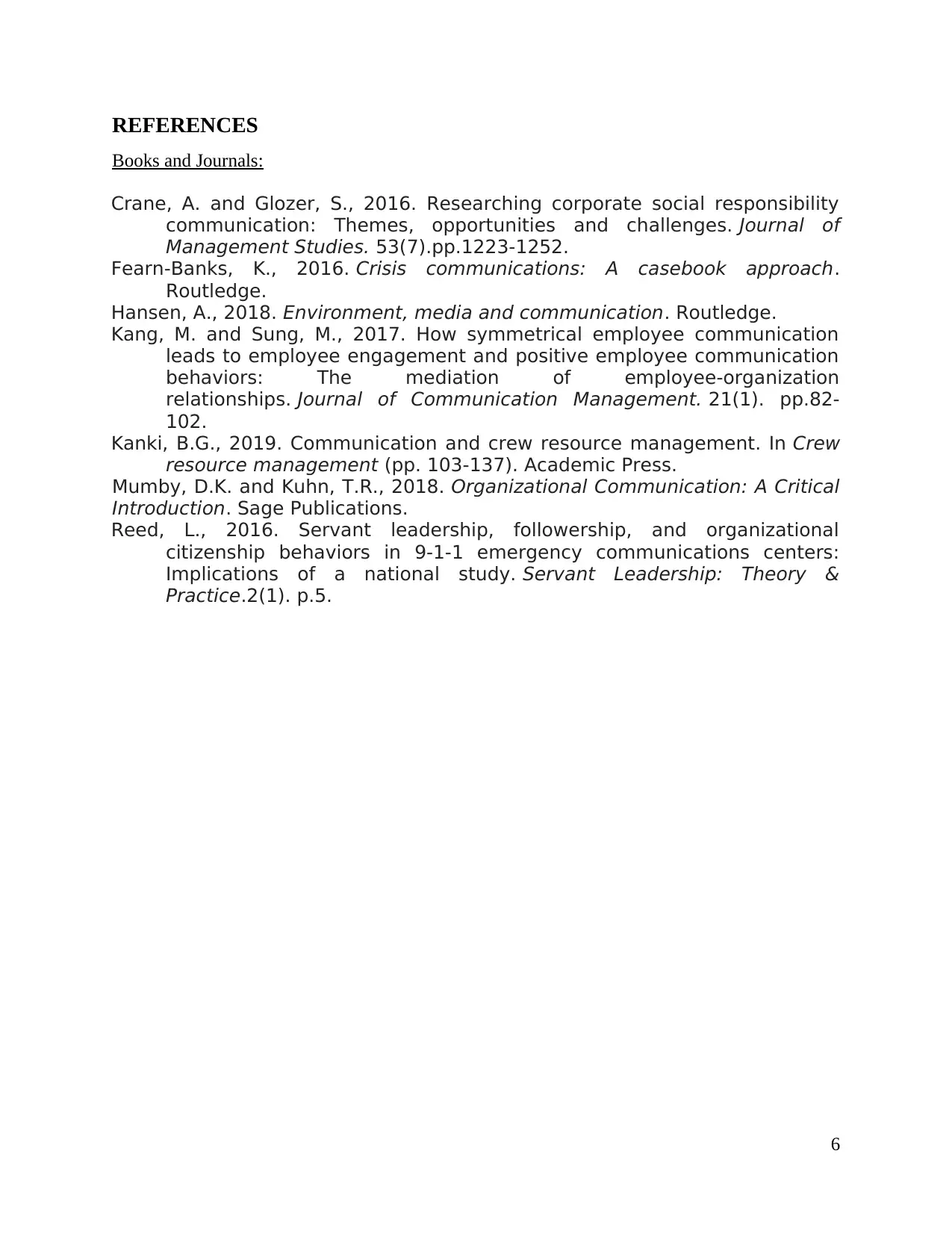
REFERENCES
Books and Journals:
Crane, A. and Glozer, S., 2016. Researching corporate social responsibility
communication: Themes, opportunities and challenges. Journal of
Management Studies. 53(7).pp.1223-1252.
Fearn-Banks, K., 2016. Crisis communications: A casebook approach.
Routledge.
Hansen, A., 2018. Environment, media and communication. Routledge.
Kang, M. and Sung, M., 2017. How symmetrical employee communication
leads to employee engagement and positive employee communication
behaviors: The mediation of employee-organization
relationships. Journal of Communication Management. 21(1). pp.82-
102.
Kanki, B.G., 2019. Communication and crew resource management. In Crew
resource management (pp. 103-137). Academic Press.
Mumby, D.K. and Kuhn, T.R., 2018. Organizational Communication: A Critical
Introduction. Sage Publications.
Reed, L., 2016. Servant leadership, followership, and organizational
citizenship behaviors in 9-1-1 emergency communications centers:
Implications of a national study. Servant Leadership: Theory &
Practice.2(1). p.5.
6
Books and Journals:
Crane, A. and Glozer, S., 2016. Researching corporate social responsibility
communication: Themes, opportunities and challenges. Journal of
Management Studies. 53(7).pp.1223-1252.
Fearn-Banks, K., 2016. Crisis communications: A casebook approach.
Routledge.
Hansen, A., 2018. Environment, media and communication. Routledge.
Kang, M. and Sung, M., 2017. How symmetrical employee communication
leads to employee engagement and positive employee communication
behaviors: The mediation of employee-organization
relationships. Journal of Communication Management. 21(1). pp.82-
102.
Kanki, B.G., 2019. Communication and crew resource management. In Crew
resource management (pp. 103-137). Academic Press.
Mumby, D.K. and Kuhn, T.R., 2018. Organizational Communication: A Critical
Introduction. Sage Publications.
Reed, L., 2016. Servant leadership, followership, and organizational
citizenship behaviors in 9-1-1 emergency communications centers:
Implications of a national study. Servant Leadership: Theory &
Practice.2(1). p.5.
6
⊘ This is a preview!⊘
Do you want full access?
Subscribe today to unlock all pages.

Trusted by 1+ million students worldwide
1 out of 9
Related Documents
Your All-in-One AI-Powered Toolkit for Academic Success.
+13062052269
info@desklib.com
Available 24*7 on WhatsApp / Email
![[object Object]](/_next/static/media/star-bottom.7253800d.svg)
Unlock your academic potential
Copyright © 2020–2025 A2Z Services. All Rights Reserved. Developed and managed by ZUCOL.





